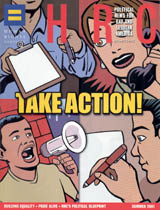
Source: Human Rights Campaign
HRC Quarterly – Summer 2001
Written by Kate Frankfurt
The Human Rights Campaign’s board of directors voted in March to expand the organization’s mission statement to include gender expression and identity. Hailed by transgender activists, the move has brought the mission statement into line with the work HRC has been doing for years.
“We at HRC believe that changing our mission statement is an honest reflection of HRC’s work at this moment in the institution’s history,” said Executive Director Elizabeth Birch. “Although HRC’s primary focus is on issues related to sexual orientation, it also has an important institutional commitment to issues related to gender expression and identity. HRC views this step as honest and proportional.”
HRC’s concerted work on issues related to gender expression and identity began in 1995 when, after holding meetings with transgender activists, HRC provided federal lobby training for members of GenderPAC, a national gender rights advocacy group. Since then, the work has grown to include efforts to add gender identity to federal hate crimes laws and direct advocacy for inclusion in corporate non-discrimination policies, to name just two examples.
“More and more state-level bills and proposed local ordinances are including gender identity and expression, representing a increasing awareness of the concerns of transgender people across the country,” said Liz Seaton, HRC’s deputy field director. “Likewise, the work HRC has been doing over the years on trans issues has evolved to span several of our departments. We see it in our lobbying, in our WorkNet and FamilyNet projects, in our state work and our legal work. This experience created a growing consensus that there is a link between discrimination based on sexual orientation and discrimination based on gender expression and gender identity.”
While HRC has taken the position of leading with the work and letting the words follow, transgender activists had long been pressing HRC to change its mission statement.
“This move is a tremendous affirmation of unity in the GLBT movement,” said Shannon Minter, senior staff attorney at the National Center for Lesbian Rights and a transgender activist. “There is no longer contentious debate about the creation of a movement that includes transgender. HRC has been a focus on this issue because of their visibility. What they say and do matters.”
Dana Rivers, vice chair of the International Foundation for Gender Education and an independent consultant on gender identity, said the move “represents the growing change in climate in America to protect trans people. A trans person dies in this country every month due to hate-motivated violence or bias. HRC’s move is a signal that they get it.”
Riki Wilchins, executive director of GenderPAC, contributed to HRC’s early thinking on transgender issues through meetings with HRC staff and board members. “HRC’s new mission statement is a giant leap forward in bringing full equality not only to those who identify as transgender, but also to gays and lesbians who are oppressed because of their gender,” Wilchins said. “We thank HRC for the opportunity to help them in their transition to a more inclusive vision.”
For some, the move brings with it questions about how and whether HRC’s ongoing work will change. “The organization is committed to educating Congress and the public at large on issues that affect transgender Americans and will continue this work on the local, state and federal levels in coalition with transgender organizations and leadership,” said Winnie Stachelberg, HRC’s political director. “The Local Law Enforcement Enhancement Act includes coverage of real or perceived gender. The Employment Non-Discrimination Act will not change substantially in form or substance.”
HRC will continue to work to ensure that transgender Americans are covered under the Local Law Enforcement Enhancement Act and will continue its work to advance supportive policies in America’s workplaces. But there are no plans at this time to alter ENDA to add gender identity because many congressional members are invested in the bill in its current form and would not welcome any changes, Stachelberg said.
“We are committed to working with transgender leaders to assist in the creation of other federal legislative vehicles to protect people based on gender expression and identity,” said Nancy Buermeyer, HRC’s deputy director for legislation.
“Civil rights have always been won incrementally,” she added. “While many in the transgender community are encouraged by HRC’s work, we recognize that there is an underlying vein of frustration about ENDA. We hope that the end result will be to build stronger relationships and bridges with the community and that we can come to agreement on common goals if not common strategy.”
“The issues that affect lesbian, gay and bisexual Americans and transgender Americans are often related to one another,” Birch said. “Whether viewed as being on an integrated or parallel journey, transgender Americans are an important part of our collective quest for equality.”
Frankfurt is a freelance writer based in Trumansburg, N.Y.